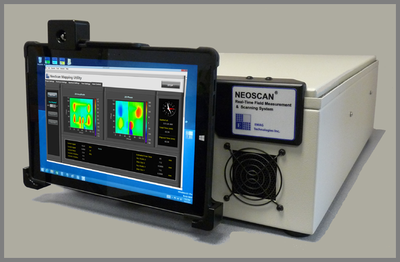The Electro-Optic Effect
The operation of the NeoScan system is based on the Pockels electro-optic effect, which predicts the phase retardation and change of the polarization state of an optical beam in an electro-optic (EO) crystal due to an impinging electric field. This effect is observed in non-centrosymmetric crystals when an electric field directed along certain crystal axes causes a change in the indices of refraction encountered by a propagating optical beam. The electro-optic effect provides a means of modulating the phase or intensity of the optical radiation. It also makes it possible to detect the presence of an external electric field impinging on an EO crystal. The polarization state of an optical beam travelling through an EO crystal is altered by the electric field in that crystal. A comparison of the original polarization states of the optical beam before and after interacting with the crystal allows a determination of the amplitude and phase of the impinging RF electric field. Since the electro-optic sensing phenomenon relies on small displacements of the atomic crystal structure, the response time of the process is extremely short. This short response time makes it possible to measure high-frequency electric fields up to the terahertz regime.
NeoScan Electro-Optic Field Probes
A typical EO probe is composed of an optical fiber affixed with an EO crystal. A low-noise 1550nm laser is used as the optical beam source. The beam is delivered to the optical probe through a fiber-based optical mainframe. The polarization of the beam is modulated by the electric field penetrating the EO crystal tip. The modulated beam is reflected back into the fiber, and back to the mainframe for analysis. The intensity of the output optical beam is linearly proportional to the strength of the external electric field at the probe tip location. The beam intensity is then converted to an output RF signal for digital signal processing.
Unlike the conventional electric field measurement techniques which require some type of resonant metal structure to detect an RF signal, NeoScanâs unique EO probes involve no metal components. As a result, the field perturbation caused by introducing the probe tip within the vicinity of a device under test (DUT) is significantly reduced. With its broad measurement bandwidth and high spatial resolution, NeoScan provides a non-invasive, versatile means to characterize RF systems including microwave and millimeter-wave integrated circuits and antennas.
NeoScan field probes are supplied with polarization maintaining (PM) fibers of certain lengths. The end of the fiber is connected to the NeoScan optical mainframe using an FC/APC fiber connector. Since NeoScan's underlying principle of operation is based on the polarization modulation of an optical beam, the use of PM fiber plays a critical role in maintaining the integrity of the sampled field data. Our standard field probes come with fiber lengths of 10m, 20m and 50m. A large standoff distance allows you to place the probe far away from the optical mainframe. This is a significant advantage for probing high power microwave systems or for near-field scanning of high power transmitting phased array antennas.
Measuring Amplitude and Phase of Polarimetric Fields
The anisotropic nature of the EO probe tip allows accurate measurement of all the three components of the electric field with a high degree of polarization purity. The NeoScan system features both tangential and normal field probes. A normal EO probe is only sensitive to the electric field component parallel to the probe axis, whereas a tangential probe is sensitive to the electric field component perpendicular to the probe axis and parallel to the EO crystal orientation. By synchronizing its optical and RF signal processing system with the RF signal generator feeding the device under test (DUT), NeoScan is also able to measure the relative phase of the electric field sampled by its probe very accurately. The current NeoScan system is capable of measuring signals with instantaneous bandwidths up to 20GHz and signal levels as low as 1V/m. Because the optical probes are completely free of metallic parts, there are no free electron surfaces to generate arcing. As a result, it is possible to measure extremely high field strengths up to 2MV/m or even higher using the same field probes.



